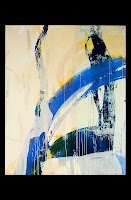
Large Abstract Landscapes
FPAC is catching up with Michael Eder about his work on view at 35 Channel Center Street:
FPAC- What inspires you to paint landscape paintings? How did it all begin?
ME- I was always drawn outdoors to paint, from college days at RISD 30 years ago, and still today. I love the chaos and energy of working from an enormous still life, even if it's moving and changing. I carry that energy indoors to my studio and finish my larger work there.

FPAC- Rice Fields, Vietnam and the Desert Paintings at 35 Channel Center Street, are both inspired by black and white photos. Why/how did these photos become a focus in your work?
ME- To my surprise I found a similar energy and wealth of ideas in black and white photos that I get from working outdoors. An added bonus is they bring me places I can't go, and allow me to have greater choices in subjects and moods. It began when I came across photos of deserts in the US and tried and found plenty there to inspire larger oil paintings. I then found the photojournalist book from the 70's "Vietnam, Inc" and was inspired by the landscapes surrounding the victims and perpetrators of the war. I made studies in a series of woodcuts, and moved to larger and larger canvases, to better surround the viewer in the mood of the landscape.

FPAC- As an artist who uses color, how did you choose the colors for your paintings when working from black and white photos?
ME- When I paint outdoors I look more at the way light works than at color relationships. I leave those to chance, which can sometimes fail, or it can create surprises. The black and white photos move me in the same way being outdoors can, looking at the drama of lights and darks.
FPAC- How does your medium (oil paint) become parallel in your vision for the final outcome? I guess I am asking, what is it about oils that contributes to your work, what is unique about them? Are all of your works done in oil?
ME- Oils allow me to layer large areas easily, and work the subtleties with the slow drying wet paint. The surface stays "alive" longer. As lights and darks are so important to the final outcome for me, I find oils give me the greatest scope to work with. All my paintings are oils. I also use monoprints and woodcuts for studies, as they are good for layering, and are a great tool for exploring ideas.
FPAC-Your work appears to have many layers, can you tell us a little about your process?
ME- It's mostly intuitive. I refer back to studies, more recently to photos, and to other paintings to help me along. I respond to people's responses, and might continue on a piece for years. More often it takes several months to finish a painting. The layers are not intentional, but are the result of searching for better answers. Failed paintings are usually ones I cover up with color and hide that process of searching.
FPAC- Do you always work in large format? -( all of Eders' paintigns at 35 Channel Center Street are between 5-8 feet )
ME- A majority of paintings in the last 5 years are large. I do many small oils on wood, 12 inch square or so, as

outdoor studies. I also do prints and smaller watercolors. I like the large size because of the fuller experience it can give the viewer.
FPAC- Who is your favorite artist (s) and why?
ME- I constantly change my preferences. Long ago it was Arthur Dove and Hartley. A room full of Kandinsky at the Fogg stuck with me for years, as did a Florine Stettheimer. I love the fragile carvings and watercolors of Anne Chu. I admire many strong artists, like Gerhard Richter and Baselitz, but I love more tentative work.
FPAC- Whats next on the horizon for you?

ME- I'm working on a series on Gettysburg after a visit there last spring. I'm using Mathew Brady's civil war photos to build woodcut studies and currently three large paintings.
Check out Michael Eder's work at 35 Channel Center Street, Fort Point Boston and learn more about him at http://www.michael-eder.com/
All photos courtesy of Michael Eder, except black and white photo- by Phillip Jones courtesy of Vietnam Ink








